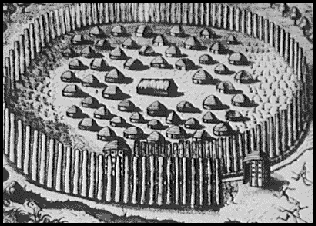Bimbling

|
More Bits and Another Bimble We met Carole and
Bruce just as we were entering the San Sebastian
Winery – for a tour and tasting
 A palisaded Timucua village, in an engraving based on a sketch by Jacques le Moyne
Founding of St. Augustine: Pedro Menéndez de Avilés sighted land on the 28th of August 1565, (the feast day of Augustine of Hippo) naming the territory was named San Agustín. The Spanish sailed through the St. Augustine Inlet into Matanzas Bay and disembarked near the Timucua town of Seloy on the 7th of September. Menéndez's goal was to dig a quick fortification to protect his people and supplies as they were unloaded from the ships. Later to take a more proper survey of the area to determine the best location for the fort. The location of this early fort has been confirmed through archaeological excavations directed by Kathleen Deagan on the grounds of what is now the Fountain of Youth Archaeological Park. It is known that the Spanish occupied several structures in Seloy, the chief of which was allied with the Saturiwa, Laudonnière's allies. It is possible that Menéndez fortified one of the occupied Timucua structures as his first fort at Seloy.
Castillo de San Marcos, completed 1695
In the meantime, Jean Ribault, Laudonnière's old commander, arrived at Fort Caroline with more settlers for the colony, as well as soldiers and weapons to defend them. He also took over as governor of the settlement. Despite Laudonnière's wishes, Ribault put most of these soldiers aboard his ships for an assault on St. Augustine. However, he was surprised at sea by a violent storm lasting several days. This gave Menéndez the opportunity to march his forces overland for surprise dawn attack on the Fort Caroline garrison, which then numbered several hundred people. Laudonnière and some survivors fled to the woods, the Spanish killed almost everyone in the fort sparing the women and children. With the French displaced, Menéndez rechristened the fort as San Mateo appropriating it for his own purposes. The Spanish then returned south and eventually encountered the survivors of Ribault's fleet near the inlet at the southern end of Anastasia Island. Menéndez executed most of the survivors, including Ribault; this is how the inlet got its name Matanzas (the Spanish word for slaughter). The first slaves in the territory were brought to St. Augustine on the day it was founded by Avilés, it is said his contract with King Phillip afforded him three years to import five hundred African slaves. In 1566, Martín de Argüelles was born in San Agustín, the first European child who was recorded as born in the continental United States. Argüelles was born twenty one years before the English settlement at Roanoke Island in Virginia Colony and forty two years before the successful settlements of Santa Fe, New Mexico and Jamestown, Virginia. The first recorded birth of a black child in the continental United States is in the Cathedral Parish Archives, Augustin was born in the year 1606, thirteen years before enslaved Africans were first brought to the English colony at Jamestown in 1619.
A wander around the small
History Museum
An injured toe caused me to borrow Trooper. Don’t slip on the banana peel, unhappy landing in the oyster bed
ALL IN ALL A VARIED DAY |